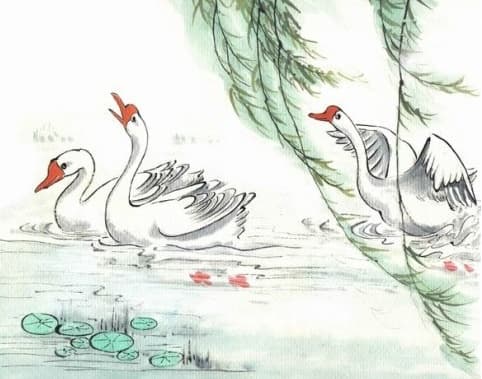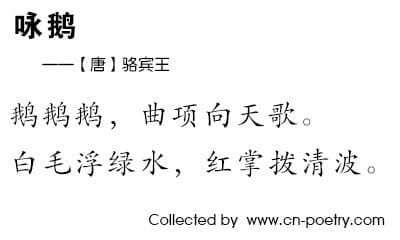An Ode to the Goose
- Poetry of Luo Binwang

Goose, goose, goose,
You bend your neck towards the sky and sing.
Your white feathers float on the emerald water,
Your red feet push the clear waves.
Written by Tang Dynasty poet Luo Binwang when he was only seven years old, “An Ode to the Goose” is a particularly simple and easy to memorize poem, resulting in it often being one of the very first famous Chinese poems to be learned by Chinese children.
Written when he was just 7 years old, this poem conveys a sense of the innocent, yet detailed observations of a child towards the immensity of nature. Later widely acknowledged as the one of four distinguished Tang poets, Luo reveals his brilliancy in poetry at a young age. Although he focuses on a seemingly insignificant part of nature (geese!), the poet reveals his deeper connection with nature through an activation of a plethora of senses.
Beginning with a simple word — 鹅 (geese) — repeated thrice, readers recognize the simple, carefree spirit of the poet and can expect a refreshing and lighthearted piece of work. The poet then proceeds to focus on the body parts of geese and connect them to an aspect of nature: 曲项 (curved necks), 白毛 (white feathers), and 红掌 (red webbed feet) are all simple, yet elegant two-worded descriptions of geese; all three body parts directly engage with nature, revealing the close connections between animals and nature. However, Luo does not simply correlate animals with nature — in reality, he also weaves a tightly-knitted relationship between beauty and nature. The vivid descriptions of the setting serves to portray the gentle serenity of the natural environment. In truth, the childlike observations of nature remind readers to sometimes stop and simply admire the beauty of their natural surroundings.
鹅、鹅、鹅,曲项向天歌。
白毛浮绿水,红掌拨清波。

- Why Chinese poems is so special?
- The most distinctive features of Chinese poetry are: concision- many poems are only four lines, and few are much longer than eight; ambiguity- number, tense and parts of speech are often undetermined, creating particularly rich interpretative possibilities; and structure- most poems follow quite strict formal patterns which have beauty in themselves as well as highlighting meaningful contrasts.
- How to read a Chinese poem?
- Like an English poem, but more so. Everything is there for a reason, so try to find that reason. Think about all the possible connotations, and be aware of the different possibilities of number and tense. Look for contrasts: within lines, between the lines of each couplet and between successive couplets. Above all, don't worry about what the poet meant- find your meaning.
List of Chinese poets
Pre-Qin Poetry
Han poetry
Ban Gu Cao Cao Cao Zhi Cao Pi Cai Wenji Kong Rong Liu Bang Liu Che Qin Jia Ruan Ji Su Wu Wang Can Xiang Yu Xu Gan Zhang Heng AnonymousSix Dynasties Poetry
Tao Yuanming Zhang HuaTang poetry
Bai Juyi Bao Junhui Cen Shen Chen Zi'ang Cui Hao Chang Jian Cui Tu Chen Tao Du Fu Du Mu Du Shenyan Dai Shulun Du Xunhe Du Qiuniang Gao Shi Gu Kuang Gao Pian Han Yu He Zhizhang Han Hong Huangfu Ran Han Wo Huang Chao Jia Dao Jiaoran Jin Changzu Li Bai (Li Po) Li He Li Shangyin Liu Yuxi Liu Zongyuan Luo Binwang Li Qi Liu Changqing Lu Lun Li Shen Li Yu Li Qiao Li Yi Liu Fangping Liu Zhongyong Li Ye Meng Haoran Meng Jiao Ma Dai Pei Di Qian Qi Quan Deyu Sikong Shu Song Zhiwen Shen Quanqi Shangguan Wan'er Xuanzong of Tang Wang Bo Wang Changling Wang Wei Wang Zhihuan Wei Yingwu Wen Tingyun Wang Han Wei Zhuang Wang Wan Xue Tao Xu Hun Xu Hui Yuan Zhen Yu Xuanji Yu Shinan Yuan Jie Zhang Jiuling Zhang Ji Zhang Hu Zhang Zhihe Zu Yong Zhang Xu Zhu Qingyu Zheng Tian Zhang Bi Zhang RuoxuSong Poetry
Cai Xiang Chao Chongzhi Fan Chengda Fan Zhongyan Huang Tingjian He Zhu Kou Zhun Jiang Kui Lu You Li Qingzhao Liu Yong Mei Yaochen Ouyang Xiu Pan Lang Qin Guan Qian Weiyan Su Shi Su Zhe Song Qi Wang Anshi Wen Tianxiang Weng Juan Xin Qiji Yang Wanli Yue Fei Yan Jidao Yan Shu Ye Shaoweng Zeng Gong Zhang Xian Zhou Bangyan Zhu Shuzhen Zhu Xi Zhou DunyiYuan poetry
Bai Pu Guan Hanqing Ma Zhiyuan Xu Zaisi Yang WeizhenMing poetry
Chen Jiru Tang Yin Tang Xianzu Xu Wei Yu Qian Yang ShenQing poetry
Cao Xueqin He Shuangqing Nalan Xingde Pu Songling Tsangyang Gyatso Wang Guowei Yuan Mei Zheng Xie Zhao Yi